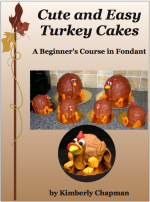I previously posted this photo as a teaser for Day of Sharing and the class I’m teaching on July 24:

Cupcake cup made out of green gummy.
I want to reserve most of the advanced gummy instructions for those who attend these events or purchase the booklet in the future, but I also want to talk about this in more detail since an interesting question was raised at Day of Sharing.
The cupcake cup above was made by putting a bit of standard gummy mix into a silicon cupcake cup and turning it slowly for a long time, dragging it over an ice pack as I went. While gummy is awesome and has many unexpected applications, it has a downside that it’s really either a solid or a liquid; the transition period between is mere seconds, never long enough to do anything that requires a viscous liquid (like piping). So with the cupcake cup, you turn and turn and turn and turn and turn until it finally solidifies. If you set it down too soon, you get this:

This was made at Day of Sharing and set aside before solidification, so the gummy flowed down the sides and left no walls.
Obviously, this methodology is tedious, especially if one wished to make an entire batch of gummy cupcake cups (which, when allowed to dry, could be used to contain many different things with the caveat that gummy is hygroscopic and will absorb moisture quickly). Someone at Day of Sharing asked a really good question: instead of turning over an icepack, couldn’t they be made by inserting one silicon cup into another with the gummy medium in between?
Inspired, I put that to the test yesterday.
First I used gummy at standard thickness. The upper cup easily went into the lower and squooshed gummy up and out.

If nothing else, this demonstrates that red gummy would be excellent for Halloween cakes.
It took some effort to ensure the gummy was evenly distributed to the top edge all around. Luckily my blue silicon cups are slightly translucent so I could see, but if I’d put the green into the blue, it would have been almost impossible to tell other than by going over the edge all around.

You can see the reddish edge of the gummy through the translucent blue cup.
I put it in the fridge for several minutes until I was sure it was completely set up, then brought it out and pulled off the bottom bit (which I threw back in the pot, because gummy is re-meltable that way, which is part of why I love experimenting with it) and rolled up the spillage on the outside. This rolled line then easily tore off since the scalloped edge forms a sort of perforation. In other words, spillover isn’t a problem.

Gummy cup with rolled edge that can easily be pulled off.
I then gently separated the cups, noting that the gummy seemed happier to stay on the upper cup, so I left it there and removed the bottom green cup.

Gummy cup resting on the exterior of the upper cup. You can see the cast-aside torn-off rolled edge to the left.
At this point I was thinking that it was working quite well and would likely be a viable methodology. Then I removed the gummy from the blue cup and this happened (cue the Sad Trombone):

A literal flop.
The walls were simply too thin to hold themselves up, and the remaining ridge from the spillover was extra weight on top that dragged them down. I threw it back in the pot to re-melt and decided to try again with thicker stuff. I still had some leftover orange from Day of Sharing so I put that in between two cupcake cups, leaving it quite thick (when you re-melt, you generally have to add some water, especially if it’s been drying out for a time). That started off okay, albeit much harder to get evenly distributed, until I noticed the extra-thick gummy was dense enough to keep flowing back down and pushing the upper cup out! So I grabbed a bottle of food colouring and stuck it in as a weight, then put the whole thing in the fridge:

Sharp-eyed fellow reverse engineer types will notice that because I had to squoosh it twice, a second wave fell out upon the first. Yes, you can stack gummy that way, although there are tricks to it...
I decided to let this one sit on the counter and dry out for about half an hour while I continued with other experiments, to see if the first one flopped because it was still too wet. However, after a short time I noticed that the same-size silicon cups had a distinct flaw in terms of using one inside the other: if you push the top one down far enough, it meets the edge too much all the way around, leading to an inevitable weakness right where strength is needed most. The lightest of touches causes this weak point to tear:

The thicker bottom on this test made it even more difficult to move without tearing that fragile edge.
In contrast, if you look at that first photo of the green cup, you’ll see that the turning method produces a rounded interior edge that strengthens the join between the walls and the bottom. It’s tricky to make that come out evenly because of the sudden solidification, but it does result in a significant structural boost.
The result of the orange test looks okay if you balance and photograph it just so:

You could almost believe this is okay if I was prepared to lie to you. I'm not. Keep reading.
But this is what it looks like from a slightly different angle, sagging at the weak point:

I named this one Schlumpy. Briefly. Then it got re-melted. I'm heartless that way.
And with the slightest breeze or touch, this is how Schlumpy really wants to sit:

The thicker walls, given time to dry, are holding up a bit better, but it's collapsing at that torn point. Time for Schlumpy to die in the pot, muahahahaha!
Meanwhile, I let the red thicken up even more and then gave that another go, not pushing down as hard as with the orange, but the problem there is it’s nigh impossible to get the extra-thick goop to distribute evenly, so you end up with this:

I guess if you wanted a raggged edge, this might work, except it's still pretty floppy and now has extra folding points at every valley.
So I thinned the red back to close to the standard recipe and tried adding more but pushing down less. The first bad result was less pushing made it hard to get rid of a bottom bubble which leaves a noticeable mark later:

It looks like a big ugly fingerprint, which isn't very appetizing, even if it's actually just from a bubble.
This also left more bubbles on the sides, as can be seen above and below:

It's pretty hard to make these go away once you've already got one cup stuck inside the other.
On the other side, there’s a part where it didn’t squoosh up evenly, leaving a thin and ragged portion:

Ragged, bubble-dented, but standing.
It is actually standing, so it’s a success from that point of view. However, the two-cup method is very tricky and leads to more failures than the turning method. Granted, the green one above has some bubbles and an uneven top edge but that’s because I was lazy about it; I could have suctioned the bubbles away while it was liquid and I could have spent more time and used more gummy to get the walls more even further up. Then any remaining ragged top edge would be small and could be trimmed off.
So in conclusion, the turning method is tedious, but provides a more structurally sound result with greater user control over issues such as bubbles. The two-cup method is plausible but no less work plus generates more failures and problems.
Now, if you had two silicon cups where one was a little smaller than the other, that might work, but all of mine are the same size despite being from different manufacturers. Better yet would be a single piece indented mold like Fred brand’s Cool Shooters shot glass ice tray, which I have used to make gummy cups and it works extremely well (although they do come out very thick and with not much interior space compared to a cupcake cup). I wonder if I could inspire Fred to make a cupcake-cup-shaped ice tray? After I post this, I’m going to suggest it via their contact page. If that’s something you’d buy, tell them!
A heart-felt thank you to the person who suggested the two-cup method, because it was a very good idea and resulted in some fun, educational experimentation. I don’t know her name, but if I find out, I’ll post full credit and more thanks.












Kim….I've been searching around as I am probably making a thesis related jelly-thing….Great info here….and here is my contribution back to you: food grade silicone to make your own molds with!
Oh I know that stuff exists…it's just expensive! And so far I do all of this experimentation/teaching/etc for free so it's hard to cost-justify mold kits.
Hi! New to gummy, and I’ve been fascinated going through your archives–I think I have a new hobby now. My boyfriend is only TOO eager to encourage me, too–especially since the 2 molds I currently own are Lego people and sharks. In adorable man-child fashion he has already decided to have the little gummi sharks “eat” the gummi Lego people.
The cupcake mold idea looks like it may be good for making gummi coins, although cookie sheet + cutters would be a lot easier. Is it worthwhile to put mini cupcake cups inside the full-size ones, or is the size difference just too much?
I haven't tried minis inside regular ones, mostly because I know they'll float and move around a lot. You could potentially weight it, but you'd need to find exactly the right weight to hold it still and not sink to the bottom before the gummy sets up.
I suspect the reason that the Ice Shots mold is so heavy-duty is precisely for these reasons: even though it was designed for ice, it too needed to have an inner core that doesn't flop around, and it needs to have the ice be thick enough to make it out of the mold in one piece.
It's definitely a tricky bit of business trying to do these hollow shapes!
If you experiment, definitely share pics or even a guest blog article. 🙂
Hmm. I’ve experimented with Jell-O-and-fruit gummies. I don’t have pictures, but I could certainly take some of what little gummi is left.